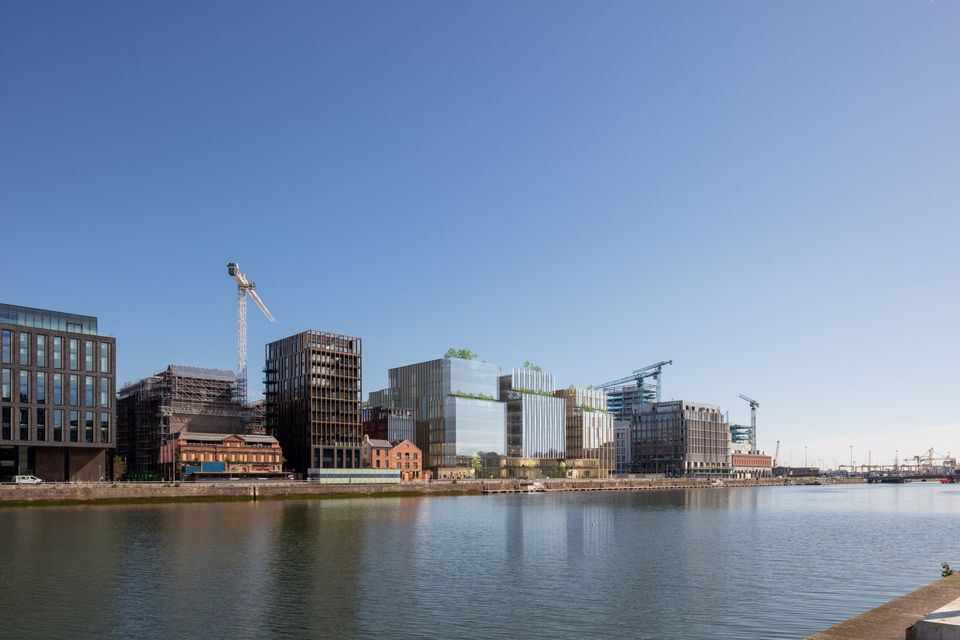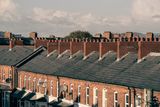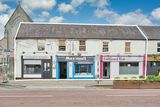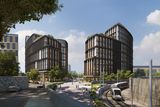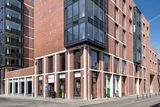The billion euro question: ‘When will commercial property prices bottom out?’
Johnny Ronan's Waterfront South Central project
Investors and commercial property agents are expecting that the recent fall in property values will bottom out in 2024 and thus present buying opportunities and generate activity. However, agents are reluctant to say how much further values may fall.
Some observers expect a bounce-back in the first half of this year, others say it may be the second half while others feel activity may not pick up until 2025.
This follows a year when the overall level of deals fell to less than €2bn which was less than half the annual average of €4.3bn seen in the 10 years up until 2022.
The exact 2023 turnover figure depends on deals that agents were still working on in the last two weeks and if some of those dragged on into this month they could boost 2024 figures.
A greater issue is the prospect of further falls in values especially for offices which has caused investors to be cautious.
According to agents JLL, office values fell 20.3pc in the 12 months to the end of September while industrial values fell 6.2pc and retail 5pc over the same period. Those falls across all sectors were sparked by rising interest rates and the difficulty experienced by investors in raising funding.
However, in the last few weeks capital markets have become hopeful that interest rates have peaked and may even decline in 2024, although some Irish estate agents are more sanguine.
James Nugent, of Lisney, says interest rates are not the only factor affecting the market.
“The working-from-home trend is also having a major impact on demand for office space and rents and this has a knock-on effect on values.
“Another issue is ESG requirements, as the cost of upgrading office to environmental standards has not yet been factored into values for older offices.”
Yet another factor is new supply. John McCartney, of BNP Paribas Real Estate, expects the office vacancy rate to peak at about 16pc this year as new supply comes on stream, leaving an overhang of about 220,000 sq m.
“On the other hand, with the taps turned off on new development, that overhang could be absorbed within 15 to 30 months depending on the pace of take-up,” he adds.
Read more
The faster absorption rate may be possible considering that Declan O’Reilly, of Knight Frank, has identified active requirements for close to 230,000 sq m of office space.
He says that professional service firms such as accountants and lawyers account for 35pc of this demand, finance firms for 19pc, the State sector 15pc, tech sector 13pc, medical/pharma sector 6pc, co-working 4pc and others 8pc. Among those potential occupiers are EY, Deloitte and the EU anti-money laundering agency.
Apart from that figure, not all of the office space currently being developed will come on the market as there are four major projects already spoken for including: Hibernia’s Harcourt Square development, pre-let to KPMG, Johnny Ronan’s Waterfront South Central, pre-let to Citigroup, A&L Goodbody’s 25 North Wall Quay and Google’s Boland’s Bakery.
O’Reilly believes that absorption could also benefit from “a swing back towards greater office attendance with a growing number of occupiers issuing return-to-work mandates”.
He acknowledges that office values will “face a challenging first half” as price discovery will remain an issue and “we are likely to see an increase in receivership sales.
“These sales, however, will start to put a floor on values. It is important to recognise however that bond yields are falling, and interest rates are also likely to be lower by the end of 2024.
“The fundamentals underpinning the office occupier market will also start to improve next year.”
Nugent also points out that occupiers who are seeking office spaces of between 750 and 1,400 sq m are finding those very difficult to locate.
Niall Gargan, of JLL, hopes the combination of more stable interest rates and price cuts will help to reverse recent falls in values and, availing of such price reductions, McCartney says investors will recognise that “if they want to buy at the bottom of the trough then 2024 will be the year for the best deals and this could drive significant activity”.
Michele McGarry, of Colliers, says that the main buyers currently in the market are private Irish investors and French CPI’s. The latter include investment managers such as Corum and Iroko as well as some newcomers who are targeting properties in the €10m to €15m price range, offering yields of more than 7pc.
Retail agents are more bullish. Karl Stewart, of Cushman & Wakefield, says: “With shoppers returning to physical stores, retailers are looking to meet demand by seeking properties in quality locations. The results of this can been seen in many of the key high streets where vacancy levels have dropped significantly.”
He expects retail rents to increase in 2024, “particularly for high-quality units in desirable locations”.
Stewart also expects a number of new international brands to enter the Irish market including RAINS, the Danish outwear fashion brand which will open on Wicklow Street early next year.
“Our European network shows fashion continues to be the most prolific sector, particularly the athleisure and lifestyle brands. The one to watch is the EV companies who are rapidly expanding in Europe but not doing so here yet.”
His colleague Kevin Donohoe has found “investor appetite for retail (property) is changing on the back of increased occupier activity and demand, the improved occupation market and limited vacancy combined with attractive returns due to lower valuations and higher yields compared with other sectors”.
But he acknowledges it may be difficult to sustain the level of retail deals seen in 2023. Yields range from around 5.25 to 5.75pc in Dublin high street and over 7pc in regional cities depending on asset quality/lease length.
Demand for industrial and logistics accommodation is reflected in rising rents and Kevin McHugh of Harvey, expects more deals in 2024 although fewer big ones. “European institutional investors are seeking prime lots while Irish and private equity investors are looking for opportunities by buying lots to which they can add value,” he adds.
Two key challenges are low availability of stock and persuading vendors to be realistic in their price expectations.
Among the key tests of the market in 2024 will be the sale of two major Dublin shopping centres. Goldman Sachs is expected to achieve about €650m for Blanchardstown Shopping Centre and the adjoining retail parks which would be a €100m discount to what it paid for them in December 2020. US investor Oaktree Capital is looking for about €160m for The Square, Tallaght which it bought from Nama in 2019 for €250m.
The hospitality sector will be looking to the sale of two Dublin city centre hotels, the more valuable of which will be the Shelbourne Hotel, on St Stephen’s Green, for which Kennedy Wilson is reported to be seeking €260m.
Meanwhile, the liquidators of Irish Bank Resolution Corporation are expected to sell two former Sean Quinn hotels this year. They include Buswells Hotel, near Leinster House, which has a €22m price tag, and the Slieve Russell Hotel in Cavan, which has yet to be launched.
One of the biggest office deals of the new year will be the sale by US property giant Starwood of a number of commercial buildings, with some 30,000 sq m at Elmpark Green, beside St Vincent’s Hospital in Dublin 4. CBRE has been quoting €55m for these.
One of the receivership sales may see the sale of the offices known as the Beckett Building in north docklands after German lender Helaba appointed receivers to the company that owns it on behalf of South Korean investors.
Join the Irish Independent WhatsApp channel
Stay up to date with all the latest news
